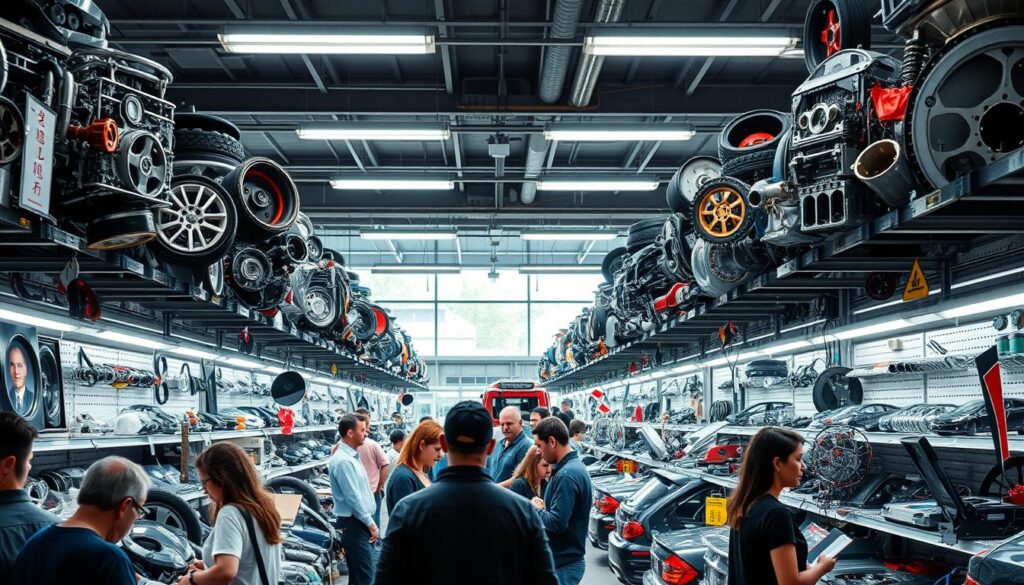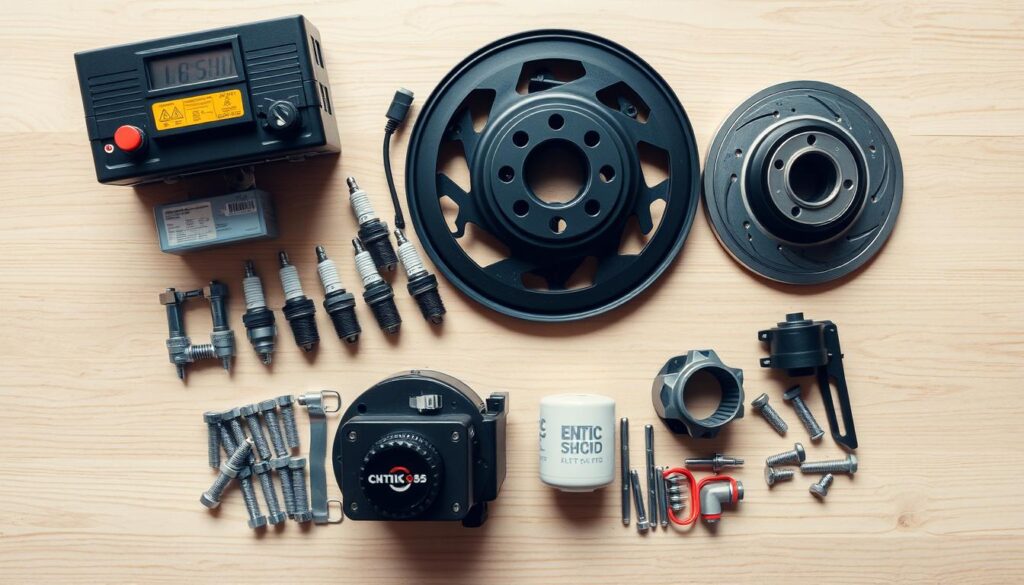How can a complex cross-border delivery become predictable and stress-free?
This introduction outlines clear steps and reliable options for moving auto parts across the U.S.–Canada border.
The U.S. and Canada share a tightly linked auto market. Exports and imports exceed tens of billions, so many businesses and vehicle owners rely on fast, trusted transport options.
Readers will find a practical guide that covers small parcel, courier, LTL and full truckload, plus forwarding services. The focus is on paperwork, transit times, and realistic cost ranges.
Expect clear advice on invoices, origin proofs, duties under USMCA, GST/HST, and brokerage fees. The guide also explains packing, insurance, and how to pick the right service for varying needs.
For tailored route planning or quotes, contact info@bestcarshippinginc.com or call (307) 288-5972 for professional support.
Key Takeaways
- Cross-border auto trade is highly integrated and efficient for most service tiers.
- Options range from low-cost parcels to LTL/FTL freight to match timetables and value.
- Prepare invoices, origin details, and proof of payment to ease customs clearance.
- Budget for transit and fees: expect parcel, courier, and freight price bands.
- Packing, handling, and insurance protect high-value auto parts in transit.
- Contact the provider early for route planning, quotes, and bookings.
Why Americans search for cross‑border auto parts solutions right now

Integrated supply chains keep vehicle manufacturing and distribution tightly linked across the border. Auto parts often cross national lines several times before final assembly. This binational flow makes sourcing across the region efficient and normal for many companies.
Integrated US‑Canada auto supply chains at present
Mutual dependence drives availability. High trade volumes mean wider selection and competitive pricing. Many buyers access U.S. inventories to avoid local markups and find new releases earlier.
When it makes sense to source and ship parts across the border
- Limited local stock or urgent repair needs favor cross‑border orders.
- Repair shops and resellers rely on U.S. inventory during demand spikes.
- Even after shipping and import costs, total landed costs can be lower.
- Choose the right service—postal, courier, or freight—based on time and sensitivity.
- Always verify seller reputation and return policies to reduce risk.
Plan quotes with GST/HST, duties, and brokerage fees in mind. For help choosing services and scenario planning, contact info@bestcarshippinginc.com or call (307) 288-5972.
How to ship auto parts step by step: from purchase to delivery

A reliable delivery starts with verifying the seller and the exact part number. Buyers often use RockAuto, AutoZone, Summit Racing, CarParts.com, eBay, Amazon, OEM sites, or salvage networks like Car-Part.com. Confirm stock, lead time, and return terms before you pay.
Prepare the order and package
Capture the invoice, payment proof, and clear descriptions. Use sturdy boxes, internal cushioning, and secure sharp edges.
Measure, weigh, and pick the right service
Measure dimensions and include packaging in the weight. Choose a method based on size and urgency: postal for economy, courier for speed, freight for bulky items, or a forwarder for a U.S. address and consolidation.
Customs data, tracking, and inspection
Complete HS-level descriptions, origin, and declared value. Track proactively and coordinate receipt. Photograph damage, verify part numbers, and file claims quickly. Keep all records for warranty or customs questions.
Need help booking or documentation? Email info@bestcarshippinginc.com or call (307) 288-5972.
Choosing the best shipping method for your part, weight, and timeline
Select a transport option that matches the part’s weight, dimensions, and urgency. Start by measuring length, width, height, and actual weight. Exact numbers give accurate quotes and prevent surprise fees.
Small parcel and postal options work well for boxed, light components under carrier size limits. USPS or Canada Post can cost about $20–$150 with 7–14 day delivery for non‑urgent items. Use postal for economy and simpler brokerage.
Courier services for faster delivery and clearance
FedEx, UPS, DHL, and Purolator deliver in 1–7 days. They cost roughly $50–$500 and assist with customs brokerage. Choose couriers for speed, tracking, and help with documentation.
LTL vs. full truckload for bulky items
Use LTL when freight fills part of a trailer; choose full truckload for large or time‑sensitive shipments. Engines and transmissions often need crating, drained fluids, and pallet securing. Expect freight costs of $200–$2,000 and transit of 5–14 days.
Freight forwarders and consolidation
Forwarders consolidate multi‑seller orders to cut costs ($50–$500) and simplify handling. This option reduces touchpoints and can speed clearance. Always verify liftgate, residential access, and other delivery constraints when booking.
Tip: Get exact dimensions and weight before requesting a quote to avoid reweigh fees and reclassification.
- Define thresholds before booking.
- Balance cost and time to meet repair schedules.
- Contact a specialist for tailored recommendations: info@bestcarshippinginc.com or (307) 288-5972.
Packing and handling guidelines to protect automotive components
Proper packing reduces damage risk and speeds customs clearance for sensitive automotive components.
Crating heavy driveline units
Crate engines and transmissions on sturdy pallets. Bolt the unit to the skid and secure with steel straps. Drain all fluids to avoid leaks and HAZMAT holds.
Body panels, exhausts, wheels, and tires
Wrap panels in foam and use edge guards. Double-box fragile finishes when possible. Cap exhaust ends, pad flanges, and brace long sections to prevent bends.
Band and brace wheels and tires to pallets so they cannot roll. Block circular items and fill voids to stop shifting under freight movement.
Electronics and interior components
Place sensors and modules in anti-static bags and cushioned boxes. Add desiccants for moisture control and label as fragile.
- Distribute weight low and centered on skids to reduce tipping.
- Include clear orientation and address labels; add an internal return address.
- Photograph items after packing to document condition before tendering.
- Confirm carrier crate specs and note if truckload or liftgate service is needed.
Tip: For tailored packing guidance, email info@bestcarshippinginc.com or call (307) 288-5972.
Customs, duties, and paperwork for shipping car parts from US to Canada
Customs checks and tax rules shape the total cost and timing of a parts delivery. Clear documentation avoids holds and unexpected fees.
GST/HST, duties, and brokerage
Budget for GST/HST at 5–15% based on the destination province. Duties on many items range from 0–10% but may be reduced.
Courier brokerage typically runs $10–$50. Freight carriers may include disbursement fees. Confirm who pays duties and when funds are collected.
Required documentation and value declarations
- Commercial invoice with full descriptions and HS codes.
- Country of origin and proof of payment.
- Accurate transaction values to meet CBSA rules.
Using USMCA origin
Obtain supplier origin statements when goods qualify. A valid USMCA claim can reduce or eliminate duties on eligible auto parts and components.
Tip: Allow extra clearance time during peak periods and keep records for audits.
For document templates or broker coordination, contact info@bestcarshippinginc.com or call (307) 288-5972 with any questions about your shipment.
Costs, quotes, and ways to save without sacrificing reliability
Smart cost control starts by isolating what actually sets a rate: size, weight, service level, and distance.
What drives cost: carriers rate shipments on dimensions and actual or dimensional weight. Faster service levels and longer lanes increase freight and fuel surcharges. Special handling, insurance, and accessorials (liftgate, residential, or appointment) add fees that quickly change the quote.
Compare quotes and leverage consolidation
Request multiple quotes across postal, courier, forwarder, and LTL/FTL options. Compare total landed costs, not just base rates. Forwarders can consolidate multiple orders into one pallet and cut per‑package brokerage and handling.
- Improve cartonization: right‑size packaging to lower dimensional weight.
- Consolidate packages: combine small orders to reduce per‑package fees.
- Avoid surprise accessorials: confirm liftgate and residential delivery needs when quoting.
When postal or ground options beat express
For non‑urgent auto or OEM items, postal and ground services often offer the best total cost. Typical ranges: USPS/Canada Post $20–$150 (7–14 days); couriers $50–$500 (1–7 days); LTL/FTL $200–$2,000 (5–14 days); forwarders $50–$500 (5–10 days).
Tip: Ship earlier and build a routing guide that pairs size classes with preferred carriers to lock in lower rates and consistent service.
Track spend per shipment and per part to find savings over time. For multi‑lane quotes or consolidation planning, email info@bestcarshippinginc.com or call (307) 288-5972.
Carriers, forwarders, and pickup options that fit your shipping needs
Pick a logistics path that balances cost, speed, and control for each component.
Couriers like FedEx, UPS, DHL, and Purolator are best for fast cross‑border moves. They offer integrated brokerage and tight tracking for small boxes and sensitive electronics. Use them when transit time and reliable clearance matter most.
Couriers and freight providers to consider for cross‑border shipments
Postal services (USPS handing off to Canada Post) work well for lighter, low‑value packages where cost tops speed. For pallets and oversized components, choose LTL carriers or truckload providers (FedEx Freight, Old Dominion, YRC) experienced in automotive freight.
Package forwarding services and border pickup strategies
Forwarders provide a U.S. address, consolidation, and export handling. They can lower per‑item brokerage but limit weight and restrict liquids or certain batteries. Border pickup at a U.S. receiving point lets customers collect goods personally or arrange a short‑haul courier for final delivery.
Tip: Verify battery, radiator, and liquid rules ahead of booking to avoid holds or extra costs.
| Option | Best for | Key advantage | Typical note |
|---|---|---|---|
| Express couriers | Small, urgent components | Fast transit and brokerage support | Higher cost, strong tracking |
| Postal | Light, non-urgent packages | Lower base fees | Longer transit, simpler brokerage |
| LTL / Truckload | Pallets, engines, large assemblies | Handles heavy freight and crated loads | Requires palletizing and appointments |
| Forwarder / Pickup | Consolidation and cost control | Combines multiple orders and paperwork | May add handling time and limits |
Request quotes from multiple companies and confirm liftgate or appointment needs. For a vetted carrier list and booking support, contact info@bestcarshippinginc.com or call (307) 288-5972.
Timelines, tracking, and insurance considerations
Timely tracking and clear insurance choices keep high-value consignments recoverable and on schedule.
Set realistic expectations early. Transit windows vary by method and lane. Visibility and the right coverage matter more when replacement lead time is long.
Typical delivery windows by method
- Postal (USPS/Canada Post): about 7–14 business days.
- Couriers (FedEx, UPS, DHL): 1–7 business days.
- LTL / truckload: 5–14 business days depending on lane and capacity.
- Forwarders and consolidation: 5–10 business days.
When to add shipper’s interest insurance
Basic carrier coverage for used goods may be limited. Often it is near $0.50 per pound and may not match replacement value.
Consider added protection for refurbished, vintage, or custom high‑performance components. Also insure when lead time or rarity inflates replacement cost.
| Method | Typical time | Insurance note |
|---|---|---|
| Postal | 7–14 business days | Basic coverage low; add insurance for value above carrier limit |
| Courier | 1–7 business days | Higher declared value options; good tracking for claims |
| LTL / Truckload | 5–14 business days | Require declared value; pallet damage risk without crating |
| Forwarder | 5–10 business days | Consolidated coverage options; check policy limits |
Tip: Track every step, inspect on delivery, and document damage on the BOL. For insurance options and tracking setup, email info@bestcarshippinginc.com or call (307) 288-5972.
Conclusion
A methodical approach links seller vetting, packing, and customs for reliable delivery.
Recap: select reputable sellers, pack for protection, choose the right service, and complete customs data to keep shipments moving.
Match method and service level to part size, value, and timeline. Measure and compare options. Consolidate where it lowers cost without risking damage.
Stay compliant by supplying full documentation and using USMCA origin claims when valid. Add insurance and track each shipment to protect investment and timelines.
Inspect on receipt and document any issues for fast resolution. For tailored planning, quotes, and bookings for shipping car parts, email info@bestcarshippinginc.com or call (307) 288-5972.
